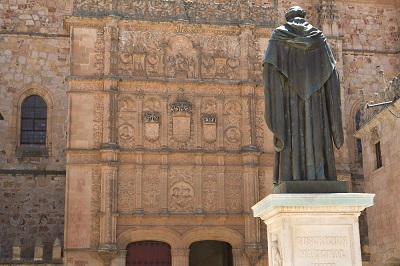
Economics, as a branch of knowledge concerned with human wellbeing, is somewhat like Jenga. The structure cannot hold if certain pieces, such as Adam Smith’s classical school, are removed.
In Economics: An Introductory Analysis, Paul Samuelson presents a “family tree of economics” noting the contribution of Aristotle, Aquinas, and medieval Schoolmen to the history of economic thought. This may have been a nod to his dissertation advisor, Joseph Schumpeter, who believed that the 16th century development of natural law theory created a framework for economics as an independent discipline. This natural law tradition was subsequently passed on to Adam Smith at the University of Glasgow.
An intense modern-day look at the economic contributions of late Hispanic Scholastic thought began with Marjorie Grice-Hutchinson (The School of Salamanca, 1952). It continued with Alejandro Chafuen (Faith and Liberty, 2003 and Raices de la Economia de Mercado en la Escolastica Catolica, 2nd Ed., 2017).
The Hispanic Scholastics were the first to formulate a quantity theory of money and purchasing power parity, foundational in the canon of economics. However, it is worthwhile to consider how their methodology employed natural law, civil law, and revelation to explore a subjective theory of value, the moral neutrality of market transactions, and personal consent.
The Hispanic Scholastics’ subjective (not to be confused with relativistic) theory of value applies to all goods, including money. Viewing consumption as the end of all economic activity implies that value is subjective, based on people’s needs and wants, even when those needs and wants are foolish. These ideas persisted on the European Continent with the ordinary person seen as a consumer rather than a producer.
In the 18th century, classical economists stressed production, inputs, and cost, even to the extent of holding to a labor theory of value. Measuring hours of labor and other inputs is relatively straightforward; whereas subjective satisfaction or utility is incapable of measurement. A theory of behavior describing how consumers reveal preferences was needed. The time had not yet come to advance theories of value into a coherent synthesis, combining subjective and objective elements.
In the 1870s, Carl Menger in Austria defined the value of an economic good in essentially Hispanic Scholastic terms, i.e. its ability to satisfy a human need. Leon Walras, a French land reformer, modeled money into ratios of exchange between goods. William Stanley Jevons, a British economist departing somewhat from Smith, derived the value of goods from revealed intensities of satisfaction. Within four years of each other Menger, Walras, and Jevons independently set the precedent for marginal supply and demand analysis for understanding market prices.
Economics, within the tradition of classical liberalism, is perceived by some to be excessively individualistic and dismissive of national sovereignty. Multigenerational poverty and the hollowing out of employment in certain sectors are serious economic issues. However, sound economic principles formulated over time by those seeking truths about the human condition and the wealth of nations are essential building blocks. There is no need for future generations to bear the economic consequences of ignoring these relatively absolute absolutes.
My recent essay at AdamSmithWorks provides a fuller summary of some of the most important ideas of the Hispanic Scholastics.
Maryann Keating O. is a research fellow at the Indiana Policy Review Foundation. She edited Paul Samuelson’s essays on Economics from the Heart (Thomas Horton and Daughters) and had co-authored several articles and books, including Microeconomics for Public Managers (Wiley-Blackwell).


Comments are closed.